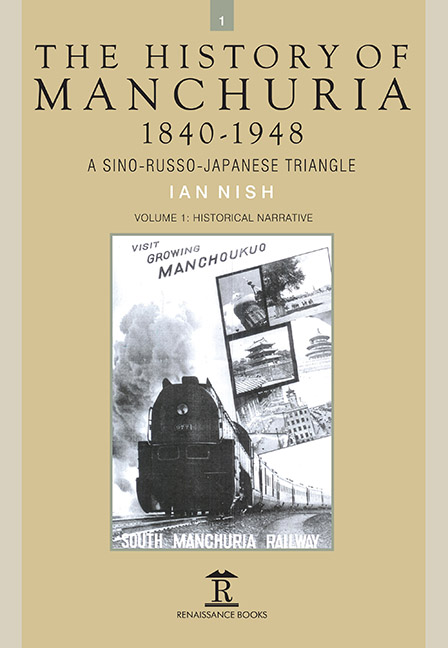Book contents
- Frontmatter
- Dedication
- Contents
- Preface
- Acknowledgements
- Name Conventions
- List of Abbreviations
- List of Maps
- Chapter One Manchuria and Russian Ambition, 1840s–1890s
- Chapter Two Sino-Japanese War and After, 1894–1900
- Chapter Three Prelude to the Russo-Japanese War, 1900–1905
- Chapter Four Railways, Reforms and Revolutions, 1906–1914
- Chapter Five Wartime Turmoil in Manchuria, 1915–1922
- Chapter Six Chang Tso-Lin’s Manchuria, 1922–28
- Chapter Seven Chinese Nationalism and Foreign Railways, 1929–1931
- Chapter Eight Lytton Commission in Manchuria, 1931–1932
- Chapter Nine Manchukuo: From Republic to Empire, 1933–1937
- Chapter Ten A Decade of Wars, 1938–1948
- Epilogue
- Map
- Select Bibliography
- Index
- Volume 2: Select Primary Sources
- Miscellaneous Frontmatter
- Dedication
- Miscellaneous Frontmatter
- Chapter 1 1840–1894
- Chapter 2 1895–1899
- Chapter 3 1900–1905
- Chapter 4 1905–1914
- Chapter 5 1915–1922
- Chapter 6 1922–1928
- Chapter 7 1929–1931
- Chapter 8 1931–1932
- Chapter 9 1933–1937
- Chapter 10 1938–1948
- Apendix Appeal by the Chinese Government
Chapter Seven - Chinese Nationalism and Foreign Railways, 1929–1931
Published online by Cambridge University Press: 18 November 2023
- Frontmatter
- Dedication
- Contents
- Preface
- Acknowledgements
- Name Conventions
- List of Abbreviations
- List of Maps
- Chapter One Manchuria and Russian Ambition, 1840s–1890s
- Chapter Two Sino-Japanese War and After, 1894–1900
- Chapter Three Prelude to the Russo-Japanese War, 1900–1905
- Chapter Four Railways, Reforms and Revolutions, 1906–1914
- Chapter Five Wartime Turmoil in Manchuria, 1915–1922
- Chapter Six Chang Tso-Lin’s Manchuria, 1922–28
- Chapter Seven Chinese Nationalism and Foreign Railways, 1929–1931
- Chapter Eight Lytton Commission in Manchuria, 1931–1932
- Chapter Nine Manchukuo: From Republic to Empire, 1933–1937
- Chapter Ten A Decade of Wars, 1938–1948
- Epilogue
- Map
- Select Bibliography
- Index
- Volume 2: Select Primary Sources
- Miscellaneous Frontmatter
- Dedication
- Miscellaneous Frontmatter
- Chapter 1 1840–1894
- Chapter 2 1895–1899
- Chapter 3 1900–1905
- Chapter 4 1905–1914
- Chapter 5 1915–1922
- Chapter 6 1922–1928
- Chapter 7 1929–1931
- Chapter 8 1931–1932
- Chapter 9 1933–1937
- Chapter 10 1938–1948
- Apendix Appeal by the Chinese Government
Summary
ONLY TIME WOULD tell whether the killing of the Old Marshal would result in chaos or orderly transition. Fortunately, the latter prevailed; and it was possible for Western sympathizers of China like Dr Dugald Christie to take an optimistic view of the future:
We may now confidently hope that a better day is dawning for China. The Nationalist rule is yet in its infancy, and its development will naturally take time, but the real work of reconstruction has begun. Already the army is being steadily reduced, and important economic and political changes are taking place.
The more wary, however, looked to the future of China the Nation with apprehension:
The nation is now actually politically organized, and the political machinery is at the mercy of whatever political gang is in power. It is absolutely based on Soviet and Facisti principles. There is no room whatever for Opposition or for real popular argument and free discussion.
The underlying popular nationalism which this bred led to the minor Sino-Russian War of 1929 and the descent of Sino-Japanese relations to bitter hostility. These two themes form the substance of this chapter.
It was some months before the circumstances of Chang Tso-lin’s death leaked out publicly. Speculation abounded about who had per petrated the crime and how and why. The purpose of the plot was specifically to get rid of Chang Tso-lin whom some Japanese saw as an obstacle to achieving their ambitions. A secondary aim was more generally to destabilize the administration in Manchuria. But as a result of Chang Hsueh-liang’s delaying tactics the predicted chaos did not materialize. Law and order were upheld and a peaceful transition to power of Hsueh-liang took place.
The bomb plot was a failure for Japan and a snub for Prime Minister Tanaka. It was locally and conspiratorially arranged and not authorized by Tokyo, either military or civilian. It was evidently not approved by the Kwantung army as a whole. It failed also as a political tactic to settle Sino-Japanese differences in a direction favourable to Japan. Amidst all the uncertainty, it was even suggested that the real perpetrators were associated with the Kuomintang and its Northern Expedition, of which Chang Tso-lin had been a long-standing opponent.
- Type
- Chapter
- Information
- The History of Manchuria, 1840-1948A Sino-Russo-Japanese Triangle, pp. 123 - 141Publisher: Amsterdam University PressPrint publication year: 2016



